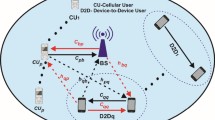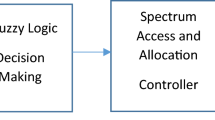Abstract
Due to limited cooperation among users and erratic nature of wireless channel, it is difficult for secondary users (SUs) to obtain exact values of system parameters, which may lead to severe interference to primary users (PUs) and cause communication interruption for SUs. In this paper, we study robust power control problem for spectrum underlay cognitive radio networks with multiple SUs and PUs under channel uncertainties. Precisely, our objective is to minimize total transmit power of SUs under the constraints that the satisfaction probabilities of both interference temperature of PUs and signal-to-interference-plus-noise ratio of SUs exceed some thresholds. With knowledge of statistical distribution of fading channel, probabilistic constraints are transformed into closed forms. Under a weighted interference temperature constraint, a globally distributed power control iterative algorithm with forgetting factor to increase convergence speed is obtained by dual decomposition methods. Numerical results show that our proposed algorithm outperforms worst case method and non-robust method.






Similar content being viewed by others
References
Akyildiz, I. F., Lee, W. Y., Vuran, M. C., & Mohanty, S. (2006). Next generation/dynamic spectrum access/cognitive radio wireless networks: A survey. Computer Networks, 50(13), 2127–2159.
Srinivasa, S., & Jafar, S. A. (2007). Cognitive radios for dynamic spectrum access-the throughput potential of cognitive radio: A theoretical perspective. IEEE Communications Magazine, 45(5), 73–79.
Li, D. (2012). Joint power and rate control combined with adaptive modulation in cognitive radio networks. Wireless Personal Communications, 63(3), 549–559.
Karaca, H. M., Kurt, T., Dicle, S. Z., & Anarim, E. (2013). Auction-based throughput maximization in cognitive radio networks under interference consrtaint. Wireless Personal Communications, 72(2), 1259–1275.
Ben-Tal, A., El Ghaoui, L., & Nemirovski, A. (2009). Robust optimization. Princeton: Princeton University Press.
Fukushima, M. (2007). Stochastic and robust approaches to optimization problems under uncertainty. In Second international conference on informatics research for development of knowledge society infrastructure (ICKS 2007).
Setoodeh, P., & Haykin, S. (2009). Robust transmit power control for cognitive radio. Proceedings of the IEEE, 97(5), 915–939.
Wang, J. H., Scutari, G., & Palomar, D. P. (2011). Robust MIMO cognitive radio via game theory. IEEE Transactions on Signal Processing, 59(3), 1183–1201.
Parsaeefard, S., & Sharafat, A. R. (2012). Robust worst-case interference control in underlay cognitive radio networks. IEEE Transactions on Vehicular Technology, 61(8), 3731–3745.
Parsaeefard, S., & Sharafat, A. R. (2013). Robust distributed power control in cognitive radio networks. IEEE Transactions on Mobile Computing, 12(4), 609–620.
Tan, C. W., Palomar, D. P., & Chiang, M. (2009). Energy-robustness tradeoff in cellular networks power control. IEEE/ACM Transactions on Networks, 17(3), 912–925.
Sun, S. Q., Ni, W. M., & Zhu, Y. (2011). Robust power control in cognitive radio networks: A distributed way. In IEEE international conference on communications (ICC 2011).
Zhou, X., Wu, B., Ho, P.-H., & Ling, X. (2011). An efficient power allocation algorithm for OFDM based underlay cognitive radio networks. In IEEE Global Telecommunications Conference (GLOBECOM 2011).
Kang, X., Zhang, R., Liang, Y.-C., & Garg, H. K. (2011). Optimal power allocation strategies for fading cognitive radio channels with primary user outage constraint. IEEE Journal on Selected Areas in Communications, 29(2), 374–383.
Son, K., Jung, B. C., Chong, S., & Sung, D. K. (2013). Power allocation policies with full and partial inter-system channel state information for cognitive radio networks. Wireless Networks, 19(1), 99–113.
Soltani, N. Y., Kim, S.-J., & Giannakis, G. B. (2013). Chance-constrained optimization of OFDMA cognitive radio uplinks. IEEE Transactions on Wireless Communications, 12(3), 1098–1107.
Zhou, P., Chang, Y. S., & Copeland, J. A. (2011). Asynchronous power control game with channel outage constraints in cognitive radio networks. In IEEE international conference on communications (ICC 2011).
Dall’Anese, E., Kim, S.-J., Giannakis, G. B., & Pupolin, S. (2011). Power control for cognitive radio networks under channel uncertainty. IEEE Transactions on Wireless Communications, 10(10), 3541–3551.
Ponukumati, D., Gao, F. F., Bode, M., Li, J. C. F., & Lei, M. (2012). Robust coordinated downlink beamforming for multicell-cognitive radio networks with probabilistic constraints. In IEEE international conference on communications (ICC 2012).
Ma, S. A., & Sun, D. C. (2013). Chance constrained robust beamforming in cognitive radio networks. IEEE Communications Letters, 17(1), 67–70.
Huang, S. H., Liu, X., & Ding, Z. (2011). Decentralized cognitive radio control based on inference from primary link control information. IEEE Journal on Selected Areas in Communications, 29(2), 394–406.
Sun, S. Q., Di, J. X., & Ni, W. M. (2010). Distributed power control based on convex optimization in cognitive radio networks. In International conference on wireless communications and signal processing (WCSP 2010).
Durowoju, Q., Arshad, K., & Moessner, K. (2012). Distributed power control algorithm for cognitive radios with primary protection via spectrum sensing under user mobility. Ad Hoc Networks, 10(5), 740–751.
Yarkan, S., & Arslan, H. (2008). Exploiting location awareness toward improved wireless system design in cognitive radio. IEEE Communications Magazine, 46(1), 128–136.
Kang, X., Liang, Y.-C., Nallanathan, A., Garg, H. K., & Zhang, R. (2009). Optimal power allocation for fading channels in cognitive radio networks: Ergodic capacity and outage capacity. IEEE Transactions on Wireless Communications, 8(2), 940–950.
Boyd, S., & Vandenberghe, L. (2004). Convex optimization. Cambridge: Cambridge University Press.
Bertsekas, D. P. (2009). Convex optimization theory. Belmont, MA: Athena Scientific.
Scutari, G., Palomar, D. P., & Barbarossa, S. (2008). Optimal linear precoding strategies for wideband non-cooperative systems based on game theory—Part II: Algorithms. IEEE Transactions on Signal Processing, 56(3), 1250–1267.
Acknowledgments
This work is supported by the National Natural Science Foundation of China under Grant No. 61171079. We thank the reviewers for their detailed, constructive and valuable reviews and comments.
Author information
Authors and Affiliations
Corresponding author
Appendix
Appendix
1.1 Proof of Equation (9)
For simplicity, we define two independent random variables \(A=\frac{p_i g_{ii} }{n_i }\) and \(B_j =\frac{p_j g_{ji} }{n_i }\). According to probability distribution, \(A\) and \(B_j \) follow exponential distribution with mean \(\updelta _i =\frac{p_i \bar{{g}}_{ii} }{n_i }\) and \(\updelta _j =\frac{p_j \bar{{g}}_{ji} }{n_i }\) respectively. The probabilistic SINR constraint is expressed as
Substituting the variables \(\updelta _i =\frac{p_i \bar{{g}}_{ii} }{n_i }\) and \(\updelta _j =\frac{p_j \bar{{g}}_{ji} }{n_i }\) into (26), we get
The proof is completed.
Rights and permissions
About this article
Cite this article
Xu, Y., Zhao, X. Robust Probabilistic Distributed Power Control Algorithm for Underlay Cognitive Radio Networks under Channel Uncertainties. Wireless Pers Commun 78, 1297–1312 (2014). https://doi.org/10.1007/s11277-014-1818-8
Published:
Issue Date:
DOI: https://doi.org/10.1007/s11277-014-1818-8




